On the Monday of my last week, I started to build the inflatable-winged airplane. I cut the fuselage nose and tail as well as the v-tail pieces on the laser cutter and then built the body up. I decided to reinforce the fuselage by adding fiberglass rods on the corners. This technique worked extremely well and the foam board feels very sturdy. I also started to assemble the motor and landing gear which all fit well on the 3D printed motor mount. I shaped a piece of foam to go around the motor at the nose in order to make the airplane more aerodynamic. I also decided to create a hatch into the nose of the fuselage which is how the electronics will be accessible. This required a new 3D printed part and while I was at it I designed a part to fit into the tail of the fuselage that would set the angle of the v-tail as well as incorporate the rear wheel. It is important what angle the v-tail is at and for my purpose I went with 110 degrees which is a relatively flat angle.
On Tuesday after obtaining the parts from the printer, I was able to assemble the tail. This included the introduction of servos and push rods that control the ruddervons, as well as finishing the rear wheel and the v-tail shape in general. This process went extremely smoothly and I am happy with the tail. On to the more difficult part of the day, I installed the landing gear. This proved to be hard as the assembly had to be done inside of the fuselage after the motor mount had already been glued in. After the plane was mostly built, I weighed all of the parts together to see how much it would weigh. It weighed 1300 grams but I will probably end up adding a larger battery for a longer flight time so I estimate that will add about 100 grams which in total is just over 3 pounds. I then used a site called “e calc” and added constraints such as wing dimensions, total weight, battery type and size, motor power and size, and prop dimensions as well as estimated lift and drag coefficients in order to calculate the performance of my plane. The best part of the calculation was learning the thrust to weight ratio was decently above 1, meaning the plane could be held perfectly vertical not generating any lift from the body and the prop would keep it hovering. After calculations I learned, in theory, my plane should fly. I then decided to build the plane without electronics and throw it as a glider. I was pleasantly surprised how smooth it flew when thrown about 15 feet. The plane kept a good form and glided nicely so now the plan is to add electronics and test it. Since I stayed late on Tuesday, I had time to continue programming the gyro stabilizer. I calibrated the ESC with the help from Andrew and I got the servos from the tail working in sync with the stabilizer. I learned a lot about the software today and I worked quite a few kinks out in order to fly. The only issue now is deciding between running the v-tail as a mix of elevator and ailerons (elevons) or as a mix of elevator and rudder (standard v-tail). The reason to use elevons instead of the standard v-tail is that without controls on the wings, the plane loses ability to roll. However, the plane might not be controllable at all and will flip too much if I don’t have wing controls.
(glide test)
On Wednesday I was able to prepare the rest of the plane and fly its maiden flight. The plane flew, however oscillated violently to the point controls were lost. The plane flew three times and did the same thing every time. After looking back at the videos, the plane would start to spin to the right, the direction of the prop, then try to balance itself out but add a strange affect to the nose as it almost overcorrected. With the help of some of the experts in the lab, we decided it would probably be best to try flattening out the tail and adding a vertical stabilizer to make it resemble a more traditional tail. This required new printed parts and shut down flights for the rest of the day. For the rest of the day after designing a new tail I worked on installing a system to warp the inflatable wing. I attached large servos and horns to carbon fiber flats and then used a silicon and epoxy to secure it all to the wing.
(v-tail flight shortly before crash)
Thursday was the best day of the internship. After completing the tail and rebuilding damaged parts the plane was ready to fly. I flew the plane in the morning and it was so close to working, however it seemed like it didn’t have enough thrust, especially with the wind conditions of the day. I spent the next bit calculating the largest prop we could use on the current system before over drawing from the esc or burning out the motor. Things weren’t working perfectly with the new props and when someone recommended a different style of a low speed, carbon fiber prop with more wing area, I felt like I had to try it. The prop completely burnt out the esc and I spent a decent amount of time replacing and troubleshooting the system. When I finally found a prop that would work I realized it would smack the ground with the landing gear on. For fun and ease I added a pontoon landing system that looked very cool and funny on the plane, however added weight and drag to the plane. This plane flew really well and was very stable and controllable. The programing was th e same as the v-tail, but the vertical stabilizer helped a ton. Unfortunately the plane crash landed as Andrew felt it was too close to the road. The rest of the day was spent rebuilding the plane and preparing it for Friday.
On Friday I tried flying the plane almost identical to how it was before, only with a slightly different motor and higher pitch prop. Unfortunately the plane did not fly mainly because I forgot to check the center of gravity and it was nose heavy as well as the stabilizer was not re-orientated after its rebuild. The flight unfortunately ripped out the tail foam board and punctured the wing. The next flight introduced the wing warping and I was extremely excited about that. Unfortunately the servos unfastened themselves and had low roll control for the plane. I then switched the program back to using a mix on the tail and tried flying that. It was so close to flying and it really wanted to take off however because of the previous crashes to the tail, the servos were uneven and harder to control on one side, eventually bringing it to the ground. I decided to trash the plane from this point as it was my last day and it would have required a lot to fix it. Looking back the plane would have been more successful if it could have taken off from the ground in order for it to gain speed to take off steadily. I also wonder about adding dihedral (a slight V to the main wing) in order to give more roll control to the plane. Overall I was extremely happy about the plane and it did have a very successful flight. The inflatable wing was a challenge due to its dimensions and texture as well as controlling a plane with only two control surfaces on the tail is hard to do. I learned a ton from my failures, even more so I think than if it had always been successful, and it was a really fun challenge to design my own plane from scratch. The internship in general was better than I ever could have imagined and I feel so much more prepared for a future in aero and engineering as a whole. I am very thankful to Dr. Jacob and everyone at the lab for supporting me and helping me through such a fun internship. Everyone at the lab went out of their way multiple times to help teach me valuable information about aerospace as well as give advice to help me with my plane. I am also extremely grateful to Pinhead for working everything out and helping me go to such an amazing summer internship.
(wing warping to turn right, right tip is pulled town and left side is pushed upwards)

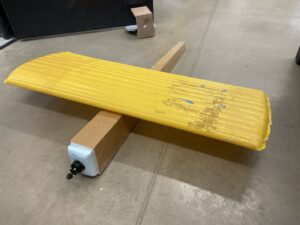
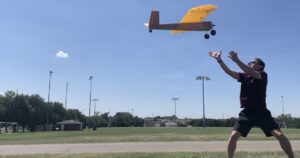
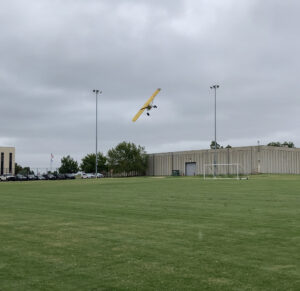
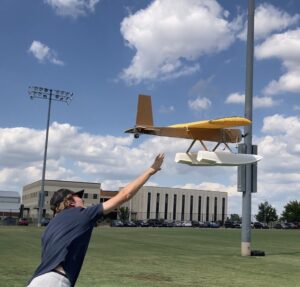
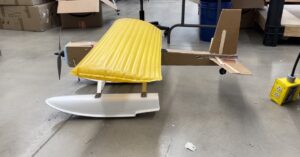
There are no comments published yet.